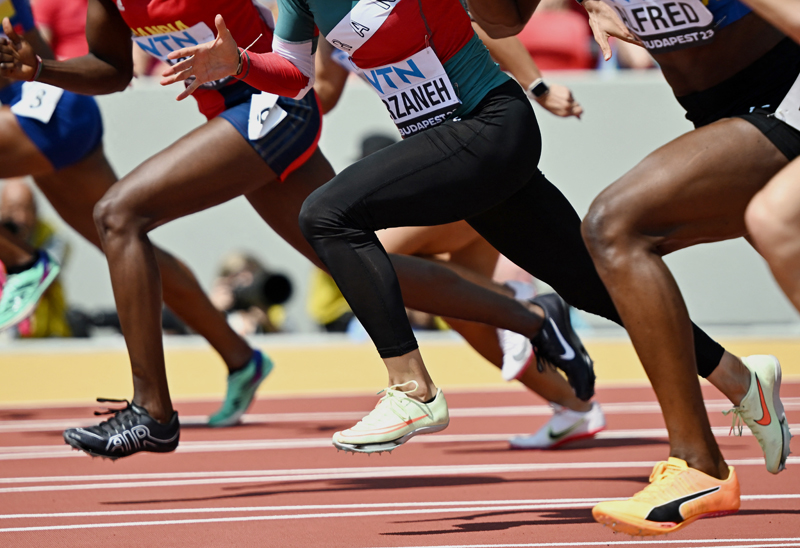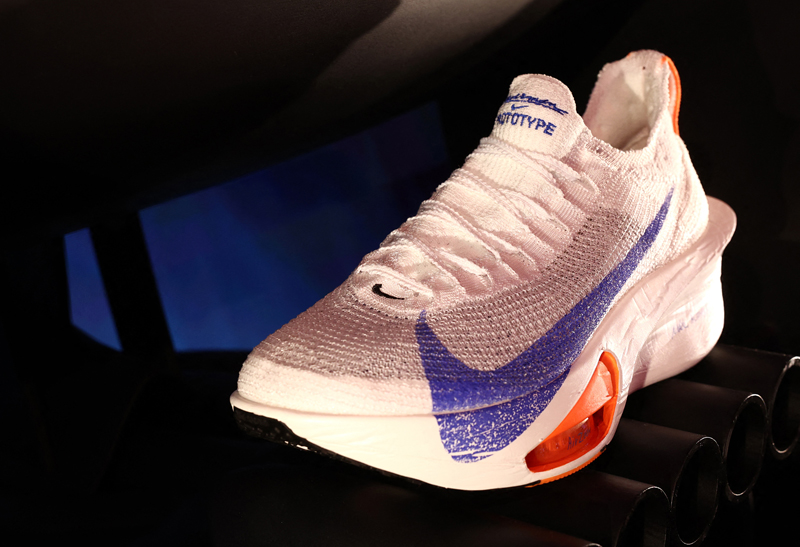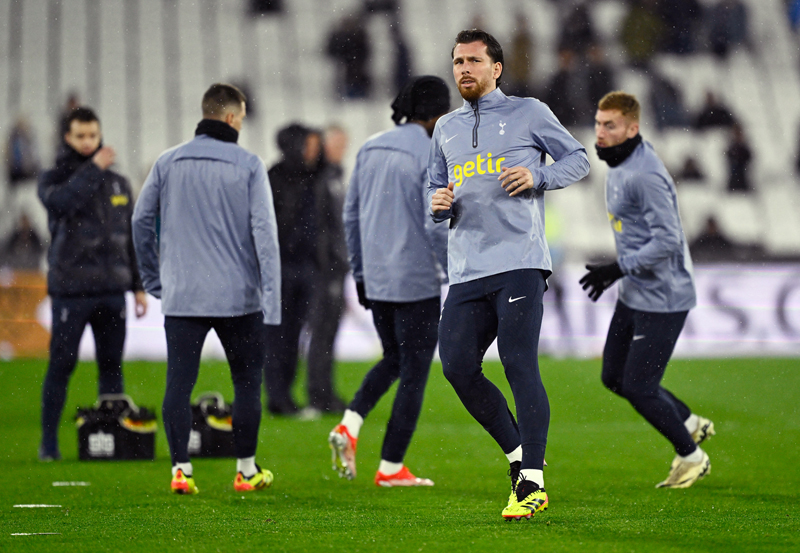Compression clothing: feel the squeeze - yes or no?

Graduated compression garments (CGs) have been used since before World War I to treat circulatory conditions; think of your grandparent’s varicose veins and the thick stockings they may have worn to decrease swelling and pain, especially if they spent most of the day on their feet! For them, the valves in the veins (the vessels that carry blood back to the heart) no longer kept the blood from backfilling and the muscles, which assist in moving the blood back to the heart, couldn’t keep up. Therefore, the CGs made up for the reduction in normal function in the body. Today’s athletes hope that wearing modern compression garments (see figure 1) can provide the same assistance with circulation – and therefore improve their performance. But do these principles translate from helping a medical condition to improving exercise physiology?
Figure 1: Skins 'calf sleeves'

A timeless classic
Graduated CGs provide the most compression to a limb at the point farthest away from the heart. The pressure in the garment gradually decreases towards the heart. Consider the ‘tube of toothpaste analogy’. When you squeeze the bottom of the tube, that part of the tube empties and toothpaste comes out the top. Like the toothpaste, the pressure from the CGs assists the blood in the veins to return to the heart more quickly and with less effort (see figure 2).Figure 2: Mode of action of CGs

Alongside the vessels of the circulatory system lie the vessels of the lymphatic system. Lymph, which is a clear liquid filled with infection fighting white blood cells, flows through the lymphatic vessels to the organs throughout the body that help combat disease. Lymph nodes, located along the lymph system, filter the lymph of toxins and assist with the fight against infection and illness.
In a healthy individual, the extra assistance with blood return from wearing a CG supposedly brings more blood to the heart with each heartbeat. This extra volume of blood in the heart stretches the heart and theoretically causes a stronger contraction of the heart muscle. The circulatory system pushes more blood through with each heartbeat, bringing more oxygen to the tissues, which theoretically increases endurance. The thought is that since the heart provides more oxygenation with less effort, it is able to maintain that level of function for a longer period of time. Also, improved lymph flow rids the tissues of metabolic toxins, produced during prolonged activity, more quickly. This is an idyllic construct, but does wearing CGs actually produce these changes in an athlete?
Designer showcase
Scientists at the Université de FrancheComté studied fifteen different commercially available calf compression sleevesJ Sports Med. 2015;2015(Article ID 857904):5 pages. They found that all of the products tested increased oxygen saturation in the legs when worn at rest. Not only that, greater compression resulted in higher oxygen saturation levels. Further research by the same group tested the hypothesis that calf compression sleeves increase oxygen saturation in the tissues of the leg during running as wellSports Med. 2011;32:1-5. They found that indeed, oxygen saturation in the skin and superficial muscles of the calf increased while wearing CGs both at rest and while running. However, despite the increased oxygenation, repeated treadmill-running trials, with and without CGs, showed no significant difference in performance.According to a study at the Radboud University in The Netherlands, CGs also effectively reduce leg volume during activityJ Athl Train. 2013 Mar-Apr;48(2):226-32. Reduced leg volume would indicate less blood pooling in the legs, and therefore potentially better performance. Thirteen participants completed a 10km track run wearing a CG on one leg. Researchers analysed the volume of both legs before and after the run using a perometer, an instrument that assesses volume using a light scanner. At the end of the run, the average leg volume measured significantly lower in the leg wearing the CG as compared to the other leg. However, this study failed to evaluate the effect of leg volume on running performance.
Passing fad?
Sports researchers from the Karlsruhe Institute of Technology in Germany undertook a systemic review of the literature available through September of 2015 to determine if wearing CGs benefited runnersSports Med. 2016 Dec;46(12):1939-1952. They reviewed studies that investigated the use of any kind of CG that covered the lower extremities - ie socks, sleeves, shorts, or tights. Of the initial 643 studies identified, only 32 met the inclusion criteria of having absolute measurable values, control as well as experimental groups of runners, and participants free of any previous health issues. The researchers made assessments on the effectiveness of CGs on several measures by evaluating the body of research as a whole.The overwhelming conclusion of this review was that wearing CGs while running or during recovery had no benefit whatsoever on running performance, no matter the distance (400m sprints through to marathon races were evaluated). This finding was despite the fact that small positive effects were noted on running economy (how efficiently the runners’ muscles were using oxygen to release energy) and biomechanical factors during running such as step frequency and step length. The effect of CGs on physiological parameters was also ‘small to negligible’. This means that the commonly held notion of the potential benefits of CGs for circulation, cardiac output and endurance were not borne out in the reviewed studies.
There were some benefits however. The effect on perceived exertion - how hard the athlete felt he/she was working - when wearing CGs was noted to be ‘small but positive’. In other words, some athletes found it ‘easier’ to run using CGs. Small, but overall positive effects were also noted in parameters measured during recovery. For instance, clearance of lactate out of the bloodstream after running slightly improved when wearing CGs. The same was true of inflammatory markers measured in the bloodstream, and the temperature of the leg muscles. Additionally, the post-run surveys suggested that there was a significant reduction in post-exercise muscle fatigue and delayed onset of muscle soreness when wearing CGs.
Keep in mind however that these last parameters are subjective measurements of how quickly and easily athletes felt they recovered from activity. Nevertheless, the researchers concluded that, while mostly small, CGs had a beneficial effect on running economy, clearance of metabolites, body temperature, and perceived exertion – all of which improved recovery outcomes. None of the studies, however, showed that these recovery outcomes improved running performance.
Figure 3: CGs - the balance of evidence

POSITIVE EFFECT
- Oxygen saturation both at rest and while running
- Running economy
- Leg volume, elimination of metabolic toxins, and temperature
- Percieved exertion, post exercise muscle soreness and delayed onset of muscle fatigue
- Endurance
- Running performance
Latest trend
The same group of scientists who looked at the effect of CGs on running performance conducted a further review on performance and recovery in endurance athletes in generalEur J Appl Physiol. 2014 Mar;114(3):587-95. They found that CGs improved cycling performance in roughly half of the cycling trials. Compression garments also decreased post-exercise soreness, delayed muscle fatigue, and increased skin temperature in approximately two thirds of the cycling studies. Four studies showed an improvement in the elimination of lactate after exercise. Despite the positive effect on cycling trials found in some of the studies, a fairly large population of triathletes (17 in the experimental group and 17 controls) showed no positive effects on overall performance while wearing lower leg compression sleeves during competitionEur J Appl Physiol. 2014 Mar;114(3):587-95.CASE STUDY: Rod Vardy

Sixty four year old Rod Vardy has been a multisport athlete in New Zealand for over 30 years. Pictured at the Auckland marathon where he finished 100th overall and first in his age group, Rod attributes his ability to maintain a rigorous training schedule to wearing CGs, like the shorts and socks shown here. He started wearing CGs in 2011 after a study at Lincoln University in New Zealand showed a positive impact on recovery. Fully aware that the evidence was still sparse, Rod gave them a try. Plagued by calf injuries, he feels wearing CGs helps, and acknowledges that this may be a perceived benefit rather than an actual one. “When I get tired, the compression garments support my muscles and this for me is the biggest benefit,” he says. Currently training up to three hours per day for the upcoming Motutapu Ultra, a 51-km mountain race, Rod plans to wear compression shorts and socks during the race, and a set of long tights afterwards to help his legs recover.
Practical considerations to help you choose
Everyone wants to look stylish, but before you don a pair of CGs, think about why you want to wear them. If you are a runner and you hope CGs will improve your performance, then the only thing getting the squeeze is your wallet. If you have a history of circulatory issues or are prone to swelling, then yes, CGs worn during competition may help that issue. If you train in cold weather, CGs increase body temperature and may help keep you warm.If you would like your legs to ‘bounce back’ more quickly after a long run, then a case can be made for wearing CGs either during exercise, or afterwards to improve recovery. However, while CGs decrease swelling, and produce a small but positive effect on the elimination of metabolites, the measurement of delayed onset muscle soreness and recovery is purely subjective. Therefore, those measures of improvement may be a result of the placebo effect. Furthermore, no one has yet studied whether a better ‘perceived recovery’ improves subsequent training, and thus performance.
Compression garments may however offer a performance advantage to cyclists. Why cycling stands out amongst other endurance activities is unclear. When deciding whether or not to try CGs it’s tempting to take the old stance of ‘what have I got to lose?’ One study of cycling performance at Lincoln University in New Zealand, found that wearing full lower-extremity compression tights between time trials was 80% likely to have a positive effect on performance, and only 2% likely to be harmfulDe Glanville, K. Teacher Fellowship Poster. 2008 royalsociety.org.nz/media/programmes-funds-teacher-fellowships-profiles-2008-kieran-de-glanville.pdf
.
What lies in that 2%? One possible downside is the effect of overpressure. For instance, if a calf sleeve applies a great deal of pressure to the patellar tendon, you could find yourself with a nasty case of tendonitis. If a sock is too compressive, your feet could feel tingly or numb. If the tights were too snug, it might limit hip range of motion, which could have its own set of problems. Since CGs increase body temperature, they could add heat stress to your run on a warm day.
Another consideration is that CGs lack standardisation in fabrication, pressure gradient, and fit. If you are a runner with thin legs, is the compression adequate? If your body type is more muscular, is it too much? And by the way, how much is enough? How do you determine if it is too much? Then there is length; which should you choose, socks, sleeves, shorts or longs? Science doesn’t have the answers for us yet so if you decide to use CGs, try several different ones to find what works for you. Remember nothing beats solid consistent training for improving times at the finish. Fashion comes and goes, but a PR you’ll have forever.
You need to be logged in to continue reading.
Please register for limited access or take a 30-day risk-free trial of Sports Performance Bulletin to experience the full benefits of a subscription. TAKE A RISK-FREE TRIAL
TAKE A RISK-FREE TRIAL
Newsletter Sign Up
Testimonials
Dr. Alexandra Fandetti-Robin, Back & Body Chiropractic
Elspeth Cowell MSCh DpodM SRCh HCPC reg
William Hunter, Nuffield Health
Newsletter Sign Up
Coaches Testimonials
Dr. Alexandra Fandetti-Robin, Back & Body Chiropractic
Elspeth Cowell MSCh DpodM SRCh HCPC reg
William Hunter, Nuffield Health
Keep up with latest sports science research and apply it to maximize performance
Today you have the chance to join a group of athletes, and sports coaches/trainers who all have something special in common...
They use the latest research to improve performance for themselves and their clients - both athletes and sports teams - with help from global specialists in the fields of sports science, sports medicine and sports psychology.
They do this by reading Sports Performance Bulletin, an easy-to-digest but serious-minded journal dedicated to high performance sports. SPB offers a wealth of information and insight into the latest research, in an easily-accessible and understood format, along with a wealth of practical recommendations.
*includes 3 coaching manuals
Get Inspired
All the latest techniques and approaches
Sports Performance Bulletin helps dedicated endurance athletes improve their performance. Sense-checking the latest sports science research, and sourcing evidence and case studies to support findings, Sports Performance Bulletin turns proven insights into easily digestible practical advice. Supporting athletes, coaches and professionals who wish to ensure their guidance and programmes are kept right up to date and based on credible science.









